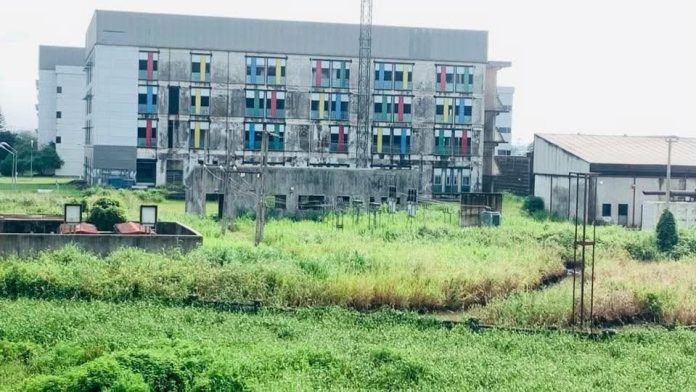In April 2025, John Essien (not his real name) was rushed into the Ibom Specialist Hospital emergency unit. He was gasping for air, his chest heaving violently, his lips tinged with the purplish hue of oxygen deprivation. His relatives clung to hope, believing they had brought him to the best health facility in Akwa Ibom State, where the best of medicine and modern care could save him.
After all, this was the same facility that former Governor Godswill Akpabio, now Nigeria’s Senate President, had proudly commissioned in 2015 with international fanfare and political flourish. Built to house 308 beds and outfitted with the latest diagnostic and treatment equipment, it was designed to eliminate the need for foreign medical trips.
But on that April day, and for Essien, all the glamour dissolved into a harrowing reality.
At first, everything seemed to fall into place. Doctors and nurses moved with urgency, rushing him into the Intensive Care Unit. A quick check showed his oxygen levels had dropped to dangerously low levels. He was placed on oxygen immediately and hooked up to a monitor.
Nearby, another patient, a woman in her late 60s, lay on a separate bed, also struggling to breathe. Both were tethered to oxygen tanks, their lives suspended on the steady hiss of gas.
But even as the machines worked, the staff knew they were on borrowed time.
In the background, a crisis was brewing, not just in Essien’s lungs but in the hospital’s supply lines; the facility was running low on oxygen.
One of the nurses at the hospital told PUNCH Healthwise that they had to ration the oxygen, lowering the flow rates and praying silently that they could hold on until morning, when help could come.
She said, “We had already alerted management earlier that week. We were told oxygen had been ordered from the government plant, but there were delays. Payments hadn’t been fully processed. We were told to manage.
“We had two patients who couldn’t live without oxygen. We managed to keep them going by rationing what little we had, but it was a race against time.”
At around midnight, the female patient’s tank ran empty. Nurses scrambled to remove the last usable cylinder from storage. They quickly hooked her up to it and managed to stabilise her. But that left Essien with nothing.
“We tried to make calls. We hoped oxygen would come that night or by morning. But we were just waiting, and then his tank went dry. He started gasping again. His body gave out. He became unresponsive, and he died just like that,” the nurse recalled bitterly.
For the staff, it wasn’t just another death. It was a haunting reminder of the gap between the hospital’s promise and its painful reality.
The nurse further narrated, “That man shouldn’t have died that night. If he was going to die, fine. But let it be that we did all we could. Unfortunately, we didn’t; we failed him, not because we wanted to, but because we had nothing to work with.”
Tale of unmet patients’ needs
Daniel Pius will never forget the day his life changed forever. What began as a simple, fun-filled outing ended in tragedy, a tragedy that Ibom Specialist Hospital could have helped prevent but couldn’t.
Pius, a second-year Akwa Ibom State University student, was known across campus for his energy. Tall, athletic, cheerful, and always joking, he had the kind of presence that filled a room. But all of that changed in March 2025.
It was the first week of the month. Pius and a few friends decided to take a break from lectures and head to a quiet stream hidden deep in the bush, not far from their campus. It was one of those spontaneous afternoon hangouts that students often look forward to.
Then, in a split second, everything went wrong.
Pius, trying to impress his friends, climbed a nearby rock to perform a backflip into the water. He had done it before. But this time, something went wrong. He landed badly.
His friends pulled him out of the water, panic rising with every second. His arms and legs hung limp. He couldn’t feel anything. He struggled to breathe. Someone called for help, and they rushed him to a small clinic nearby.
The clinic’s medical director quickly referred them to Ibom Specialist Hospital with the belief that the state’s flagship hospital would be able to handle cases of that magnitude.
When Pius arrived at Ibom Specialist Hospital, the staff didn’t rush him into emergency surgery. There was no trauma team waiting. No neurologist. No operating theatre prepared to deal with a delicate spinal injury. What he and his friends encountered instead was a bureaucratic pause.
“The MD told them they didn’t have the right facilities or the right specialists available to treat Pius properly.
“So they referred him again to the University of Uyo Teaching Hospital,” a student leader in the state told our correspondent.
At UUTH, PUNCH Healthwise gathered that Pius at least found physiotherapists and a neurology team that could begin assessments. But crucial hours had already been lost. His spinal cord had been damaged severely, and while some therapy was offered, the treatment outcomes were limited.
The student leader added, “Pius needed advanced spinal care, the kind that was only available at a specialist neurotrauma unit. He was eventually referred again, this time out of the state, to a hospital in Enugu. By then, the hope of walking again had dimmed.”
What happened to Daniel Pius and John Essien were not isolated cases. They are deeply connected threads in the unravelling fabric of a hospital that was never truly completed, despite its glistening exterior.

